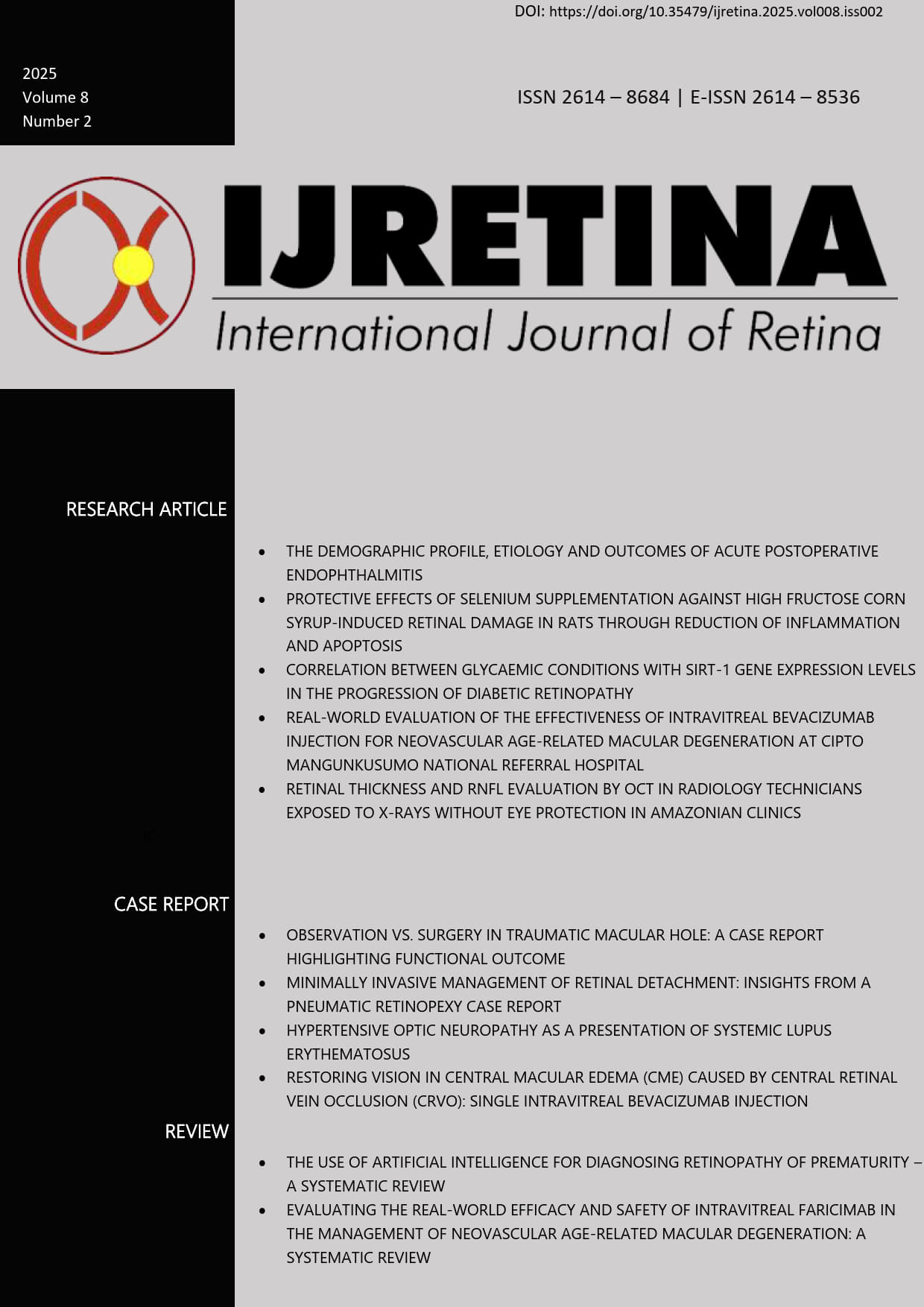RETINAL THICKNESS AND RNFL EVALUATION BY OCT IN RADIOLOGY TECHNICIANS EXPOSED TO X-RAYS WITHOUT EYE PROTECTION IN AMAZONIAN CLINICS
Main Article Content
Abstract
Introduction: While the ocular effects of ionizing radiation have been widely studied, little is known about its impact on the retinas of radiology professionals exposed daily without protective eyewear. This study aimed to assess potential morphological retinal changes using optical coherence tomography (OCT) in radiology technicians working without X-ray protective glasses.
Methods: A total of 11 radiology technicians routinely exposed to X-rays without eye protection were compared with 9 age-matched controls not exposed to ionizing radiation. Subjects with systemic conditions affecting the retina (e.g., diabetes, hypertension) were excluded. OCT scans were performed using Heidelberg Spectralis OCT to assess retinal nerve fiber layer (RNFL) thickness and global retinal thickness.Given the small sample sizes, a descriptive comparison approach was used.
Results: RNFL thickness was thinner in the exposed group compared to controls, particularly in the superior and nasal quadrants. Three individuals in the exposed group showed global retinal thickness below normal limits, compared to one in the control group. The proportion of subjects with retinal thinning was higher in the exposed group, especially in the macula and RNFL. A qualitative assessment revealed temporal macular thinning and superior RNFL thinning around the optic disc.
Conclusion: These findings suggest that chronic X-ray exposure without protective eyewear may be associated with retinal thinning and RNFL loss in radiology technicians. Given the small sample size, further research with larger cohorts is needed to confirm long-term effects and establish preventive measures.
Keywords
Retina, X-Rays exposure, Radiology technicians, radiography, Optical Coherence Tomography
Article Details

This work is licensed under a Creative Commons Attribution-NonCommercial 4.0 International License.
References
2. BChodick G, Bekiroglu N, Hauptmann M. Risk of cataract after exposure to low doses of ionizing radiation: a 20-year prospective cohort study among US radiologic technologists. Am J Epidemiol. 2008;168(6):620-31.
3. Duke-Elder S. Non-mechanical injuries. In: System of ophthalmology. London: Kimpton; 1972.
4. Fedirko P, Loganovsky K, Antypova O, Gutevych N, Syvak L, Kolosynska O, et al. Morphometric parameters of retinal macular zone in reconvalescents of acute radiation sickness (in remote period). Probl Radiac Med Radiobiol. 2018;23:481-9.
5. Hanna C. Cataract of toxic etiology: A. Radiation cataract. In: Bellows JG, editor. Cataract and abnormalities of the lens. New York: Grune & Stratton; 1975.
6. Hayes BP, Fisher RF. Influence of a prolonged period of low-dosage x-rays on the optic and ultrastructural appearances of cataract of the human lens. Br J Ophthalmol. 1979;63(7):457-64.
7. Sigurdson AJ, Doody MM, Rao RS. Cancer incidence in the US radiologic technologists health study, 1983–1998. Cancer. 2003;97(12):3080-9.
8. Hogan MJ, Zimmerman LE. Ophthalmic pathology. Philadelphia: Saunders; 1962.
9. Palva M, Palkama A. Ultrastructural lens changes in x-ray induced cataract of the rat. Acta Ophthalmol (Copenh). 1978;56(4):587-98.
10. Sahoo NK, Tanushree A, Manna S, Niyogi S, Jena S, Samanta S, et al. Radiation retinopathy: detection and management strategies. Clin Ophthalmol. 2021;15:3797-809.
11. Loganovsky KN, Marazziti D, Fedirko P, Kuts K, Antypova O, Perchuk I, et al. Radiation-induced cerebro-ophthalmic effects in humans. Life (Basel). 2020;10(4):41.
12. Tamplin MR, Grewal DS, Fekrat S. Radiation effects on retinal layers revealed by OCT, OCT-A, and perimetry as a function of dose and time from treatment. Sci Rep. 2024;14(1):3380.
13. Field GD, Chichilnisky EJ. Information processing in the primate retina: circuitry and coding. Annu Rev Neurosci. 2007;30:1-30.
14. Klein B, Klein R, Moss S. Exposure to diagnostic x-rays and incident age-related eye disease. Ophthalmic Epidemiol. 2000;7(1):61-5.

